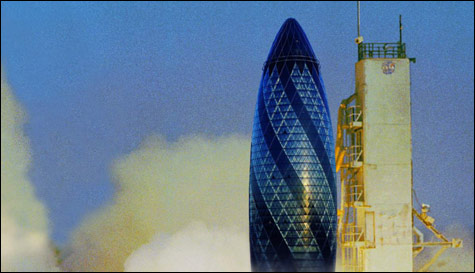
ICONS: Charles Jencks lavishes anecdotes and criticism on modern architecture that travel books usually reserve for the Tower of London or the Eiffel Tower.
|
Most travel guides are little more than lists of colorless places in which to waste your hard-earned money and sanitized tourist traps in which to waste your valuable time. So how do you find those stunning vistas, those gorgeous squares, the breathtaking contemporary architecture, and the up-and-coming neighborhoods that aren’t clogged with all the other out-of-towners? You can start with this collection of books, focusing on the best in architecture and design rather than the most familiar.
VENICE
by Alberto Bertolazzi and photographer Marcello Bertinetti and
SICILY
by Maria Cristina Castellucci and photographer Antonio Attini (both 223 pages, $24.95), the first two volumes in White Star’s “Italy from Above” series, present the lush countryside and dense cities of the region in glorious aerial photographs. Although the books do include well-known sites (St. Mark’s, the Rialto Bridge, San Giorgio), they aren’t shot as isolated sno-globe monuments but as extraordinary constructions that grow organically out of an urban fabric, a culture, and a timeless landscape.
Tiny towns that are nothing more than dots on the Michelin maps are shown clinging precariously to the sides of mountains; out-of-the-way neighborhoods most tourists miss are revealed as intimate slices of paradise sheltered beneath red-tile roofs. Seen from above, the azure seas and bustling markets become a seamless tapestry of Mediterranean life. The text is minimal; just enough to put each view into context, identify its location, and point out its important features. Future volumes, Rome and The Villages of Italy, are due out later this year.
As great as Italy looks from the clouds down, an immersion in Italian life from the ground up — as envisioned by a great architect — can be just as rewarding.
CARLO SCARPA
, edited by Guido Beltramini and Italo Zannier (Rizzoli, 320 pages, $65.00) provides an overview of the architectural work of a mid-20th-century master who combined a sensitivity to traditional materials and craftsmanship with an abstract sensibility. Scarpa’s work in Venice, Verona, and surrounding towns uses an evocative layering of walls, spaces, geometric ornamentation, and finely crafted stone and metal to evoke an image of modernity where the human hand is aided rather than replaced by the machine. Some of his buildings, like the Castelvecchio Museum in Verona, are prominent local landmarks. Others, like the Brion memorial complex near Verona, are far from the beaten path. All offer a brilliant vision of cultural transformation that is worth seeking out as a complement, or antidote, to the usual trek from ancient monument to ancient monument. Rizzoli’s fine series of architectural monographs offers similar portraits of Antonio Gaudí, Santiago Calatrava, and a host of other architects rooted in their place and time.
For an overview of the best in contemporary architecture there are a number of guides geared to the design-conscious traveler. The most comprehensive is the
ATLAS OF CONTEMPORARY WORLD ARCHITECTURE
(Phaidon, 812 pages, $160), featuring over a thousand of the most interesting buildings built since 1998. Photographs, plans, maps, descriptive text, and color-coded cross-referencing make it an ideal guidebook for the globe-trotting architecture aficionado eager to see the latest work by big-name architects or local talent. The original, weighing in at almost 18 pounds, is best left behind on the coffee table. Phaidon’s new
TRAVEL EDITION
(438 pages, $19.95) covers the same buildings with a single small photo, less text, and practical information on paying a visit. What it misses in glorious eye candy it makes up for in pocket-size convenience.
For those who prefer their architecture with a twist of lime or 400-thread count sheets, there is Wallpaper magazine’s
CITY GUIDE
(Phaidon, $8.95) series. Current volumes — actually more like oversize pamphlets — cover trendy hotels, restaurants, shops, and urban life in more than 40 cities around the world, with new ones coming out all the time. They are probably weakest on capital “A” architecture, highlighting mostly familiar icons, and strongest on fashionable — and well-designed — places to spend your money. Fold-out maps of “hot ’hoods” and lists of essential information will come in handy next time you are in Dubai, Istanbul, or New York.
The Taschen “Contemporary Architecture by Country” series by Philip Jodidio (all 192 pages, $24.95) surveys recent modern architecture that can offer experiences as extraordinary as the cathedrals and historic sites that make up the typical traveler’s itinerary. Since great contemporary design rarely grows out of a vacuum, featured projects are often cited in up-and-coming communities where the social milieu is as interesting as the individual works of architecture. A tiny restaurant by LTL Architects in
ARCHITECTURE IN THE UNITED STATES
is in Manhattan’s edgy Hell’s Kitchen neighborhood where trendy cafés, bars, and clubs are opening every day, whereas Eric Owen Moss’s exuberant Beehive building is a pioneering effort in LA’s emerging Culver City area.